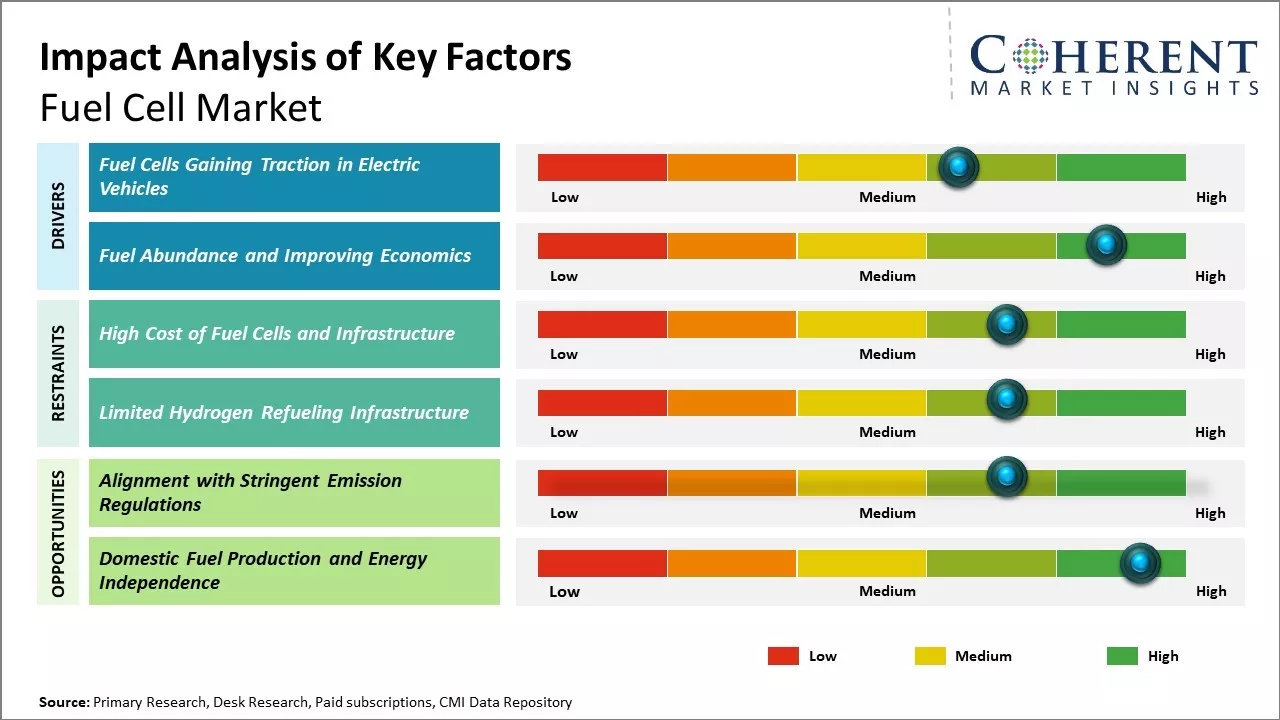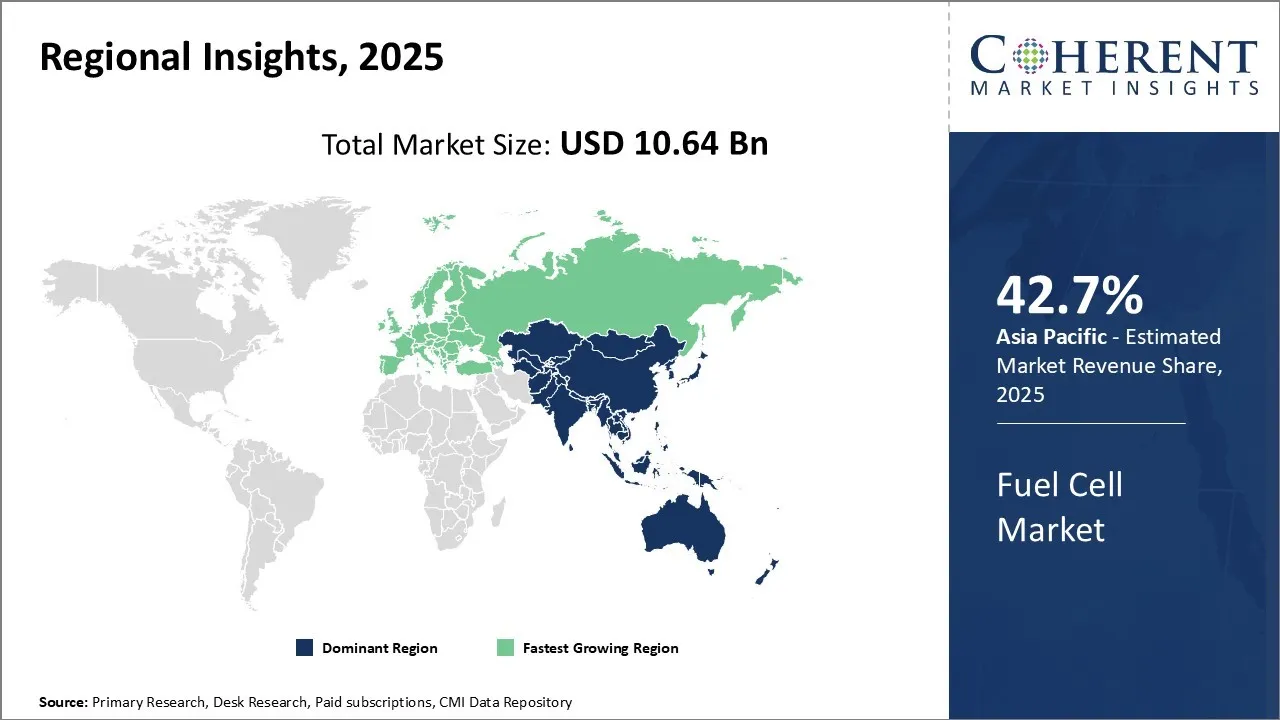The fuel cell market is estimated to be valued at USD 10.64 Bn in 2025 and is expected to reach USD 53.38 Bn by 2032, growing at a compound annual growth rate (CAGR) of 25.9% from 2025 to 2032.

To learn more about this report, Download Free Sample
The fuel cell market is expected to grow significantly over the next few years. Growing environmental concerns due to carbon emissions from traditional sources have increased demand for clean energy. Government regulations and policies related to electric vehicles, in order to mitigate pollution levels in cities, will drive the installation of fuel cells in transportation. Major auto manufacturers are heavily investing in introducing fuel-cell-powered vehicles. Advancements in technology, continuously being made, to improve the efficiency and durability of fuel cells are extending their industrial, utility, and building applications.
|
Current Events |
and its impact |
|
Global Energy Transition and Net-Zero Commitments |
|
|
Hydrogen Infrastructure Development and Policy Support |
|
Uncover macros and micros vetted on 75+ parameters: Get instant access to report
The growing demand for green, sustainable alternatives to gasoline- and diesel-powered vehicles has opened up new opportunities for fuel cell technology. Automakers have been ramping up their research and development of electric vehicles that use fuel cells to generate electricity, seeing their potential to address range anxiety that still plagues battery-electric cars.
Fuel cells boast longer driving ranges compared to traditional lithium-ion batteries, and refueling time is comparable to visiting a gas station. Major automakers such as Toyota, Hyundai, and Honda have already released models that utilize fuel cells, with most planning to considerably expand their lineups in the coming years.
More players in the industry are now realizing that fuel cells may give a better solution than batteries, especially for those commercial vehicles such as trucks and buses that require high energy capacity for extended use. Given the increasingly strict emissions regulations by governments all over the world and the financial incentives for green vehicles, this shift towards fuel cell-powered transportation means good prospects for long-term demand growth.
For instance, In April 2025, Hyundai Motor Company unveiled the all-new NEXO fuel cell electric vehicle (FCEV), a next-generation mid-size SUV, at the Seoul Mobility Show in Korea—marking a major step forward in hydrogen mobility. The new NEXO delivers strong efficiency, versatility, and safety. Powered by advanced fuel-cell technology, it produces zero tailpipe emissions and is positioned as an appealing option for early FCEV adopters.
Application-wise, the non-vehicular segment is expected to hold the largest share of 69.1% in 2025, since it is fit for stationary power generation. Fuel cells have clear advantages over combustion-based generators in baseload or backup power applications with negligible emissions. Because they are modular, scalable, and distributed, the energy solutions range from kilowatts to megawatts.
A key driver in this segment is the increasing demand for clean and reliable backup power. Such critical infrastructures as data centers, hospitals, and telecom towers require continuous energy supplies in order to perform their operations. Fuel cells prove highly useful here because they can operate independently of the grid for extended periods of time. Their fuel flexibility also makes them future-proofed compared with other technologies, which could be susceptible to fuel-availability issues over the long run.
For instance, in August 2025, Honda, Tokuyama, and Mitsubishi began a demonstration project of a stationary fuel‑cell power station that uses by‑product hydrogen and reused automotive fuel cells (FCEV units) to power a data center
Among the different types of fuel cell technologies, the Polymer Electrolyte Membrane Fuel Cells or PEMFCs will dominate with a market share of 69.42% in 2025 due to technical superiority for mobility applications. PEMFCs function at relatively lower temperatures than other fuel cell types, which makes them start up quickly and helps them change power output at a rapid pace. They also allow compact system design, which is an important consideration factor for automotive and transport use.
Key drivers for the adoption of PEMFCs include their suitability and early mover advantage for fuel cell passenger vehicles. There had been a competition for first-to-market status with the FCEVs among manufacturers, and significant investment is placed in models powered by PEMFCs. More drivers are getting access to the FCEVs as hydrogen refuelling infrastructure is incrementally expanded in regions promoting the technology.
For instance, in January 2025, HYCCO launched a 60 kW testing platform (using LT‑PEMFC stack) to accelerate development of hydrogen fuel cells, especially for heavy mobility.

To learn more about this report, Download Free Sample
The fuel cell market is expected to exhibit notable development in the future, and during 2025, it is presumed that the Asia Pacific will dominate the market with around 42.7% of the market share. The increasing demand for clean energy solutions, favorable government policies, and remarkable development in fuel cell technology are some of the major reasons for this dominance. Due to this, many countries in the region of Asia Pacific are more engaged in developing fuel cell infrastructure, which facilitates the growth of this market.
For instance, in April 2025, CPKC announced that it is doubling the size of its hydrogen locomotive test fleet with three more Ballard-powered hydrogen locomotives, further deepening its commitment to decarbonized rail.
The European region is anticipated to be the fastest-growing area within the fuel cell market, with an impressive Compound Annual Growth Rate of 27.62% by 2025. Such growth has been attributed to increased attention towards sustainability, strict environmental regulations, and a concerted push toward reducing carbon footprints. Fuel cells are being adopted in various industries-from automotive to energy production-by different European countries, which again helps the region surge at a fast pace in the market.
For instance, in October 2025, Hyundai Motor broke the ground for a major hydrogen fuel cell production facility in Ulsan; the investment for this facility was projected at KRW 930 billion to be able to produce 30,000 fuel cell units a year by 2027.
The U.S. fuel cell market has grown significantly, supported by strong government support, increased investment in hydrogen infrastructure, and a surge toward decarbonization in industrial and transport sectors. Leading participants like Plug Power, Bloom Energy, and Ballard Power Systems continue to develop and deploy stationary and road fuel cell systems.
For example, in January 2025, Ballard's data center microgrid project with Microsoft and Caterpillar-a 1.5 MW liquid hydrogen fuel cell + battery setup-received recognition by the U.S.
Germany is one of the leading European fuel cell markets, driven by the country's ambitious policy for renewable energy and strict emission norms. The government's National Hydrogen Strategy highlights large-scale production of green hydrogen, infrastructure development, and industrial use of fuel cell technology. Collaborative research and innovation hubs with EU funding programs hasten the pace of technological development in PEMFCs and SOFCs.
For instance, in March 2025, Tyczka Hydrogen announced a 5 MW electrolysis plant + a hydrogen refueling station project in Schweinfurt, Germany. The project has a €5 million grant from the Bavarian Ministry of Economic Affairs.
| Report Coverage | Details | ||
|---|---|---|---|
| Base Year: | 2024 | Market Size in 2025: | USD 10.64 Bn |
| Historical Data for: | 2020 To 2024 | Forecast Period: | 2025 To 2032 |
| Forecast Period 2025 to 2032 CAGR: | 25.9% | 2032 Value Projection: | USD 53.38 Bn |
| Geographies covered: |
|
||
| Segments covered: |
|
||
| Companies covered: |
AFC Energy PLC, AISIN , AVL , Ballard Power Systems Inc., Bloom Energy , Blue World Technologies , Bosch , Ceres Power Holdings PLC, Convion , Doosan Fuel Cell America, Inc., Fuel Cell Energy Inc., Fuji Electric India Pvt. Ltd, Horizon Fuel Cell Technologies , Hydrogenics Corporation, ITM Power PLC, Mitsubishi Hitachi Power Systems , Nedstack Fuel Cell Technology B.V., Nexceris LLC , Nuvera Fuel Cells LLC, Pragma Industries , Proton Motor Fuel Cell GmbH , Proton Power Systems PLC, Roland Gumpert , SFS Energy AG , and SOLIDpower Italia |
||
| Growth Drivers: |
|
||
| Restraints & Challenges: |
|
||
Uncover macros and micros vetted on 75+ parameters: Get instant access to report
Growing demand from the transportation and industrial sectors
The transportation and industrial sectors are increasingly adopting fuel cell technologies as a cleaner and more sustainable alternative to conventional energy sources. Fuel cells offer high energy efficiency, longer operational life, and zero emissions at the point of use, making them ideal for applications ranging from material handling equipment and buses to backup power systems and microgrids. Fuel cells can operate on hydrogen, natural gas, or other fuels and provide longer ranges and faster refueling times compared to conventional batteries, which addresses one of the main limitations of battery-electric systems.
A key aspect helping fuel cells gain adoption is the growing availability and declining costs of the fuels that power them. Whether it is hydrogen produced from natural gas or renewable methane reformed on-site, an ample and affordable domestic fuel supply is important for driving wider commercialization. Innovations enabling more efficient and economical fuel production are crucial.
Stringent emissions regulations hence create a demand for zero-emission alternatives. Fuel cells, being a clean energy technology, make energy independence possible with domestic fuel production.
The fuel cell market has attained a phase of strategic maturity, driven by both technological breakthroughs and regulatory mandates for decarbonization. Governments worldwide are offering aggressive incentives for hydrogen, with the U.S. Department of Energy announcing that over $9 billion in grants and subsidies have been issued to clean hydrogen and fuel cell projects in 2024 alone. Proton Exchange Membrane fuel cells are emerging as the de facto choice for transportation applications, with models such as the Toyota Mirai and Hyundai Nexo demonstrating real-world durability of over 500,000 kilometers under commercial operation, effectively putting to rest the preexisting lifespan concerns.
Despite these gains, the market remains polarized. Companies investing aggressively in electrolyzer production, stack efficiency, and infrastructure partnerships establish defensible moats. For instance, Ballard Power's partnership with Microsoft and Caterpillar to deploy 1.5 MW hydrogen microgrids in data centers sets a benchmark in industrial reliability.
*Definition: The fuel cell market involves the development and sale of fuel cell technology products that generate electricity through an electrochemical reaction, without combustion. Fuel cells can use hydrogen captured from natural gas or produced from renewable resources, and hydrogen fuel cells are being developed for transportation, utilities, and backup power applications. The fuel cell market is growing as concerns over emissions and energy security are increasing interest in fuel cells as a clean, efficient, and reliable alternative to combustion engines and traditional power generation.
Share
Share
About Author
Ramprasad Bhute is a Senior Research Consultant with over 6 years of experience in market research and business consulting. He manages consulting and market research projects centered on go-to-market strategy, opportunity analysis, competitive landscape, and market size estimation and forecasting. He also advises clients on identifying and targeting absolute opportunities to penetrate untapped markets.
Missing comfort of reading report in your local language? Find your preferred language :
Transform your Strategy with Exclusive Trending Reports :
Frequently Asked Questions
Joining thousands of companies around the world committed to making the Excellent Business Solutions.
View All Our Clients